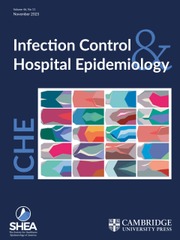No CrossRef data available.
Article contents
Sociodemographic differences in treatment of acute respiratory infections in pediatric urgent cares
Published online by Cambridge University Press: 03 December 2024
Abstract
To determine whether differences exist in antibiotic prescribing for respiratory infections in pediatric urgent cares (PUCs) by patient race/ethnicity, insurance, and language.
Multi-center cohort study.
Nine organizations (92 locations) from 22 states and Washington, DC.
Patients ages 6 months–18 years evaluated April 2022–April 2023, with acute viral respiratory infections, otitis media with effusion (OME), acute otitis media (AOM), pharyngitis, community-acquired pneumonia (CAP), and sinusitis.
We compared the use of first-line (FL) therapy as defined by published guidelines. We used race/ethnicity, insurance, and language as exposures. Multivariable logistic regression models estimated the odds of FL therapy by group.
We evaluated 396,340 ARI encounters. Among all encounters, 351,930 (88.8%) received FL therapy (98% for viral respiratory infections, 85.4% for AOM, 96.0% for streptococcal pharyngitis, 83.6% for sinusitis). OME and CAP had the lowest rates of FL therapy (49.9% and 60.7%, respectively). Adjusted odds of receiving FL therapy were higher in Black Non-Hispanic (NH) (adjusted odds ratio [aOR] 1.53 [1.47, 1.59]), Asian NH (aOR 1.46 [1.40, 1.53], and Hispanic children (aOR 1.37 [1.33, 1.41]), compared to White NH. Additionally, odds of receiving FL therapy were higher in children with Medicaid/Medicare (aOR 1.21 [1.18–1.24]) and self-pay (aOR 1.18 [1.1–1.27]) compared to those with commercial insurance.
This multicenter collaborative showed lower rates of FL therapy for children of the White NH race and those with commercial insurance compared to other groups. Exploring these differences through a health equity lens is important for developing mitigating strategies.
- Type
- Original Article
- Information
- Copyright
- © The Author(s), 2024. Published by Cambridge University Press on behalf of The Society for Healthcare Epidemiology of America



